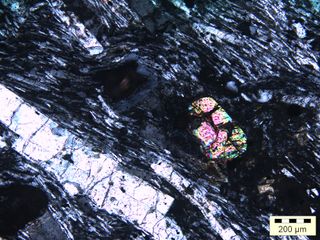
It's official: A 3-billion-year-old "lost continent" lurks beneath the Indian Ocean island of Mauritius, new research confirms.
Sparkly, iridescent flecks of rocks known as zircons from Mauritius date back billions of years, to one of the earliest periods in Earth's history, the researchers found. Other rocks on the island, by contrast, are no more than 9 million years old.
"The fact that we have found zircons of this age proves that there are much older crustal materials under Mauritius that could only have originated from a continent," Lewis Ashwal, lead author of the new study and a geologist at the University of the Witwatersrand, Johannesburg in South Africa, said in a statement.
Earth's crust is made up of two parts: the planet's continents, which rise high above the oceans because they are composed of lighter rocks such as granite; and the ocean basins, which sink lower because they are made up of denser rocks such as basalt, according to a video about the new study. Whereas the continental crust may be 4 billion years old, oceanic crust is much younger, and is continually being formed as molten rock spews through fissures in the ocean floor, called midocean ridges. [See Photos of the World's Weirdest Geologic Formations]
The traditional thinking is that the island of Mauritius was formed by volcanic activity stemming from one of these midocean ridges, meaning older crust shouldn't be there.
But the new study suggests that a tiny sliver of a primeval continent might have been left behind when the supercontinent Gondwana split up into Africa, India, Australia and Antarctica more than 200 million years ago. Then, the fiery birth of the island blanketed the primeval rock in layer after layer of cooling lava, building up the bulk of the island that is visible today, the researchers said.
"According to the new results, this breakup did not involve a simple splitting of the ancient supercontinent of Gondwana, but rather a complex splintering took place, with fragments of continental crust of variable sizes left adrift within the evolving Indian Ocean basin," Ashwal said.
Sign up for the Live Science daily newsletter now
Get the world’s most fascinating discoveries delivered straight to your inbox.
The new findings buttress results from a 2013 study that also found traces of ancient zircons in beach sand on the relatively young island. However, critics contended that this zircon could have traveled there in trade winds or been carried along on someone's shoes. In the new study, however, the zircons were found embedded in 6-million-year-old rock known as trachyte, ruling out the notion of wind-blown transfer, Ashwal said.
The findings were published Tuesday Jan. 31 in the journal Nature Communications.
Originally published on Live Science.

Tia is the managing editor and was previously a senior writer for Live Science. Her work has appeared in Scientific American, Wired.com and other outlets. She holds a master's degree in bioengineering from the University of Washington, a graduate certificate in science writing from UC Santa Cruz and a bachelor's degree in mechanical engineering from the University of Texas at Austin. Tia was part of a team at the Milwaukee Journal Sentinel that published the Empty Cradles series on preterm births, which won multiple awards, including the 2012 Casey Medal for Meritorious Journalism.